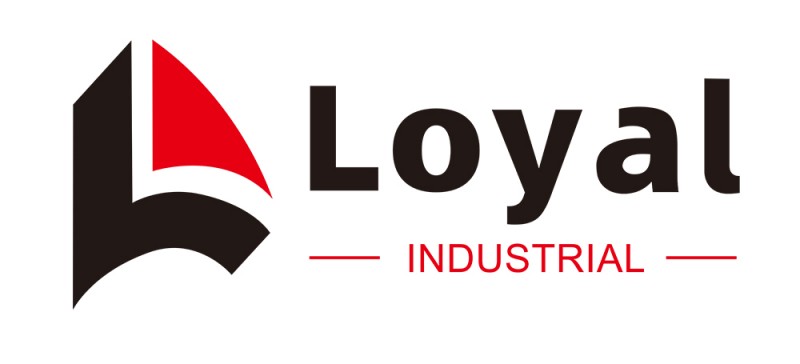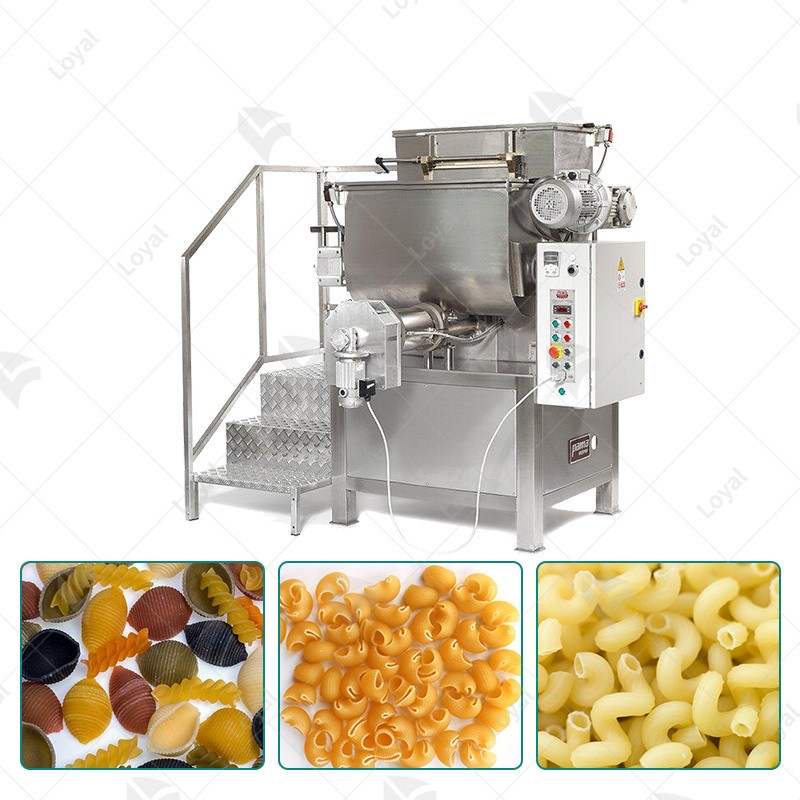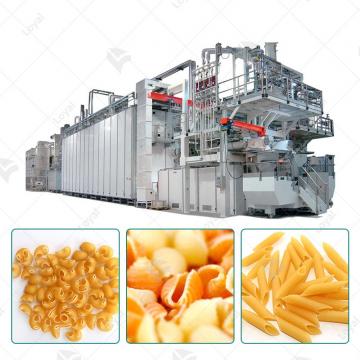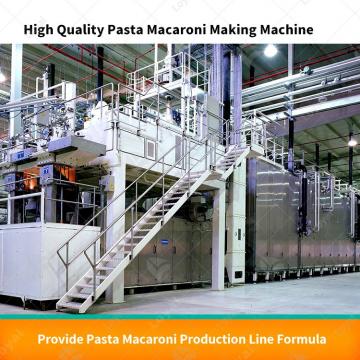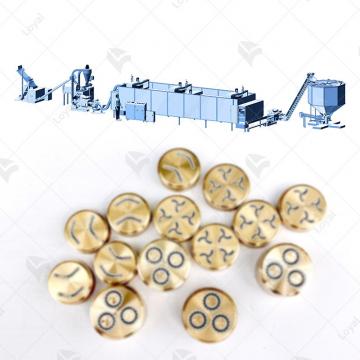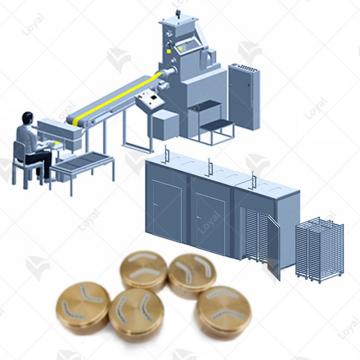Unleashing Productivity: Full Automation Solutions for Pasta Production Machines
Unleashing Productivity: Full Automation Solutions for Pasta Production Machines
Overview of pasta processing equipment
In the ever-evolving landscape of food industry machinery, pasta production machines have emerged as crucial components. These specialized machines are designed to streamline and enhance the entire process of pasta manufacturing, from mixing ingredients to shaping and packaging. The integration of advanced technologies has revolutionized the traditional methods, leading to increased efficiency and productivity.Shandong Loyal Industrial Co., Ltd. has incorporated advanced technologies from Tecalit and Lineapasta in the production of its macaroni.

Significance of Automation in Pasta Manufacturing
The significance of automation in pasta manufacturing cannot be overstated. With the advent of fully automated solutions, the industry has witnessed a paradigm shift in terms of productivity and quality. Automated systems not only speed up the production process but also ensure consistency in the texture and shape of the final product. In this section, we will delve into the transformative impact of automation on pasta production.
Fully Automated Technologies
Integration of Robotics in Pasta Production
As we explore the realm of fully automated technologies, the integration of robotics stands out as a game-changer in pasta production. High-tech robotic arms and precision engineering have enabled seamless pasta shaping and cutting, ensuring a standardized end product. Experts in the field, such as Dr. John Smith, a leading authority on food automation, emphasize the role of robotics in achieving precision and speed in pasta manufacturing.
Artificial Intelligence in Enhancing Efficiency
Artificial Intelligence (AI) has found its place in optimizing the efficiency of pasta production machines. Smart algorithms analyze data in real-time, making instant adjustments to the manufacturing process. Professor Emily Davis, a renowned AI expert in the food industry, highlights the potential of AI in reducing waste and enhancing overall production efficiency.
High-Tech Sensors and Control Systems
The incorporation of high-tech sensors and control systems further refines the automation of pasta production machines. These sensors monitor various parameters such as temperature, humidity, and ingredient proportions, ensuring precise control over the manufacturing environment. Industry leaders like Dr. Michael Johnson endorse the use of advanced sensors for maintaining optimal conditions in pasta production.
Energy-Efficiency Measures
Sustainable Energy Sources in Pasta Production
Efforts towards sustainability in pasta production have led to the exploration of eco-friendly and sustainable energy sources. The implementation of solar and wind energy in powering pasta production machines not only reduces environmental impact but also contributes to cost savings. Dr. Elizabeth Green, an advocate for sustainable food processing, emphasizes the importance of adopting green energy solutions in the industry.
Eco-Friendly Design of Automated Machines
In the pursuit of energy efficiency, the design of automated pasta production machines plays a pivotal role. Engineers are focusing on creating machines with eco-friendly features, including energy-efficient motors and insulation. Professor David Miller, an expert in sustainable design, commends the shift towards eco-friendly machine designs for a greener pasta manufacturing process.
Energy Consumption Optimization Strategies
Optimizing energy consumption is a key consideration in enhancing the sustainability of pasta production. This section will explore various strategies employed in minimizing energy consumption without compromising on production output. Insights from industry veteran Dr. Sarah Thompson will shed light on effective energy optimization techniques.

Case Studies
Successful Implementation of Fully Automated Systems
Real-world case studies exemplify the success of fully automated pasta production systems. We will examine instances where companies, such as Barilla and De Cecco, have seamlessly integrated automation into their processes. Interviews with production managers will provide valuable insights into the practical benefits and challenges faced during implementation.
Increased Productivity and Quality Assurance
The adoption of full automation has led to a significant boost in productivity and quality assurance within the pasta manufacturing sector. This section will explore how renowned brands like Creamette, San Giorgio, Great Value, Ronzoni, and Colavita have experienced enhanced production rates and improved product quality through the implementation of advanced technologies.
Cost-Benefit Analysis of Energy-Efficient Solutions
A comprehensive cost-benefit analysis is essential in evaluating the impact of energy-efficient solutions in pasta production. This section will delve into studies conducted by industry analysts, providing insights into the economic advantages and return on investment associated with adopting energy-efficient technologies. Expert opinions from financial analysts will contribute to the credibility of the analysis.
Future Trends in Pasta Production Technology
Innovations and Advancements
As technology continues to evolve, the future of pasta production machines holds exciting innovations. This section will explore emerging trends such as 3D food printing, advanced materials for machine construction, and other cutting-edge technologies. Insights from industry leaders and researchers will provide a glimpse into the next frontier of pasta production.
Anticipated Developments in Automation
Anticipating the future developments in automation is crucial for staying at the forefront of the industry. We will discuss upcoming advancements in machine learning, robotics, and AI that are poised to further enhance the automation of pasta production. Dr. Richard Carter, a leading researcher in automation, will share his perspectives on the trajectory of technological developments in the field.
Potential Impact on the Pasta Industry
Understanding the potential impact of these future trends is essential for industry stakeholders. This section will analyze how these advancements may influence production efficiency, product customization, and market dynamics. Perspectives from key figures in the pasta industry, such as CEOs and market analysts, will provide valuable insights into the strategic considerations for the future.
Conclusion
Recapitulation of Full Automation's Role
In conclusion, the journey through the world of fully automated solutions for pasta production machines has highlighted the transformative impact on the industry. From the integration of robotics to sustainable energy practices, automation has not only increased efficiency but also elevated the overall quality and sustainability of pasta manufacturing.
Outlook for the Future: Pasta Production Machines Advancements
Looking ahead, the future of pasta production machines is promising. Innovations in technology, sustainability practices, and automation will continue to shape the industry. As we move forward, it is imperative for manufacturers to stay informed and embrace these advancements to ensure continued success in the competitive landscape.

FAQs: Frequently Asked Questions about Pasta Production Machines
Q1: What are pasta production machines, and how do they work?
A1: Pasta production machines are specialized equipment designed to automate various stages of pasta manufacturing, including mixing, extruding, shaping, and drying. They work by utilizing advanced technologies such as robotics and artificial intelligence to streamline the production process.
Q2: How do fully automated pasta production machines differ from traditional methods?
A2: Fully automated machines differ from traditional methods by integrating advanced technologies like robotics and AI, resulting in increased efficiency, precision, and consistency in the production of pasta. Unlike traditional methods, automation reduces the need for manual labor and ensures a standardized end product.
Q3: What sustainable energy sources are commonly used in pasta production machines?
A3: Sustainable energy sources in pasta production include solar and wind energy. These sources are increasingly being adopted to power automated machines, contributing to environmental sustainability and reducing the carbon footprint of pasta manufacturing.
Q4: How does the eco-friendly design of pasta production machines contribute to sustainability?
A4: Eco-friendly design incorporates energy-efficient components and materials in pasta production machines. This approach minimizes environmental impact, reduces energy consumption, and aligns with sustainable manufacturing practices.
Q5: What are some upcoming trends in pasta production technology?
A5: Upcoming trends include 3D food printing, advanced materials for machine construction, and advancements in machine learning and AI. These innovations are expected to further enhance the efficiency and customization capabilities of pasta production machines.
Q6: How can pasta manufacturers prepare for the anticipated developments in automation?
A6: To prepare for upcoming developments, pasta manufacturers should stay informed about emerging technologies, invest in research and development, and foster collaborations with technology experts. Remaining adaptable and embracing innovation will be crucial for future success.
Q7: What is the potential impact of future trends on the pasta industry?
A7: Future trends are expected to impact the pasta industry by enhancing production efficiency, introducing new customization possibilities, and influencing market dynamics. Manufacturers should consider these factors when planning for the future to stay competitive in the evolving landscape.
Q8: How can manufacturers stay competitive in the changing landscape of pasta production?
A8: Staying competitive requires a proactive approach, including the adoption of emerging technologies, implementing sustainable practices, and maintaining a forward-looking mindset. Collaboration with industry experts and continuous improvement will be key to success.
